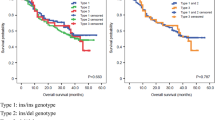Abstract
Toll-like receptors (TLRs) play important roles in the signaling of many pathogen-related molecules and endogenous proteins associated with immune activation. −196 to −174del polymorphism affects the TLR2 gene and alters its promoter activity. We investigated the influence of TLR2 −196 to −174del polymorphism on the risk of gastro-duodenal diseases, on the severity of Helicobacter pylori-induced gastritis in a Japanesepopulation. The study was performed on 309 patients with abdominal discomfort and 146 healthy controls. −196 to −174del polymorphism of TLR2 was investigated by allele-specific polymerase chain reaction method in all of the subjects. Gastritis scores of antral gastric mucosa were assessed according to the updated Sydney system in H. pylori-positive subjects (n = 156). Patients with abdominal discomfort was consisted of 80 gastric ulcers (25.9%), 38 duodenal ulcers (12.3%), five gastric + duodenal ulcers (1.6%), 105 patients with gastritis (34.0%) and 81 normal healthy stomachs (26.2%). We did not find any association between TLR2 polymorphism and risk of gastric ulcer, duodenal ulcer, gastric and duodenal ulcer and gastritis compared to healthy controls. However, the TLR2−196 to −174ins allele was associated with severity of intestinal metaplasia in more than 60 years of ages (P = 0.02). The same allele also increased the risks of developing more severe gastric mucosal atrophy and intestinal metaplasia in female subjects (P < 0.05, P = 0.07 respectively). No association was observed between TLR2 polymorphism and severity of neutrophil and mononuclear cell infiltration. Our data suggest that the TLR2−196 to −174ins allele was associated with more severe intestinal metaplasia in patients older than was correlated with severity of gastric mucosal atrophy and intestinal metaplasia in female subjects.



Similar content being viewed by others
References
NIH Consensus Conference (1994) Helicobacter pylori in peptic ulcer disease. NIH consensus development panel on Helicobacter pylori in peptic ulcer disease. JAMA 272:65–69
Uemura N, Okamoto S, Yamamoto S, Matsumura N, Yamaguchi S, Yamakido M, Taniyama K, Sasaki N, Schlemper RJ (2001) Helicobacter pylori infection and the development of gastric cancer. N Engl J Med 345:784–789
Parsonnet J, Friedman GD, Vandersteen DP, Chang Y, Vogelman JH, Orentreich N, Sibley RK (1991) Helicobacter pylori infection and the risk of gastric carcinoma. N Engl J Med 325:1127–1131
Huang JQ, Sridhar S, Chen Y, Hunt RH (1998) Meta-analysis of the relationship between Helicobacter pylori seropositivity and gastric cancer. Gastroenterology 114:1169–1179
Blaser MJ, Parsonnet J (1994) Parasitism by the “slow” bacterium Helicobacter pylori leads to altered gastric homeostasis and neoplasia. J Clin Invest 94:4–8
Meyer-ter-Vehn T, Covacci A, Kist M, Pahl HL (2000) Helicobacter pylori activates mitogen-activated protein kinase cascades and induces expression of the proto-oncogenes c-fos and c-jun. J Biol Chem 275:16064–16072
Keates S, Hitti YS, Upton M, Kelly CP (1997) Helicobacter pylori infection activates NF-kappa B in gastric epithelial cells. Gastroenterology 113:1099–1109
Maeda S, Akanuma M, Mitsuno Y, Hirata Y, Ogura K, Yoshida H, Shiratori Y, Omata M (2001) Distinct mechanism of Helicobacter pylori-mediated NF-kappa B activation between gastric cancer cells and monocytic cells. J Biol Chem 276:44856–44864
Aihara M, Tsuchimoto D, Takizawa H, Azuma A, Wakebe H, Ohmoto Y, Imagawa K, Kikuchi M, Mukaida N, Matsushima K (1997) Mechanisms involved in Helicobacter pylori-induced interleukin-8 production by a gastric cancer cell line, MKN45. Infect Immun 65:3218–3224
Crowe SE, Alvarez L, Dytoc M, Hunt RH, Muller M, Sherman P, Patel J, Jin Y, Ernst PB (1995) Expression of interleukin 8 and CD54 by human gastric epithelium after Helicobacter pylori infection in vitro. Gastroenterology 108:65–74
Akira S, Takeda K, Kaisho T (2001) Toll-like receptors: critical proteins linking innate and acquired immunity. Nat Immunol 2:675–680
Underhill DM, Ozinsky A (2002) Toll-like receptors: key mediators of microbe detection. Curr Opin Immunol 14:103–110
Medzhitov R (2001) Toll-like receptors and innate immunity. Nat Rev Immunol 1:135–45
Schnare M, Barton GM, Holt AC, Takeda K, Akira S, Medzhitov R (2001) Toll-like receptors control activation of adaptive immune responses. Nat Immunol 2:947–950
Ozinsky A, Underhill DM, Fontenot JD, Hajjar AM, Smith KD, Wilson CB, Schroeder L, Aderem A (2000) The repertoire for pattern recognition of pathogens by the innate immune system is defined by cooperation between toll-like receptors. Proc Natl Acad Sci USA 97:13766–13771
Ding SZ, Torok AM, Smith MF Jr, Goldberg JB (2005) Toll-like receptor 2-mediated gene expression in epithelial cells during Helicobacter pylori infection. Helicobacter 10:193–204
Smith MF Jr, Mitchell A, Li G, Ding S, Fitzmaurice AM, Ryan K, Crowe S, Goldberg JB (2003) Toll-like receptor (TLR) 2 and TLR5, but not TLR4, are required for Helicobacter pylori-induced NF-kappa B activation and chemokine expression by epithelial cells. J Biol Chem 278:32552–32560
Noguchi E, Nishimura F, Fukai H, Kim J, Ichikawa K, Shibasaki M, Arinami T (2004) An association study of asthma and total serum immunoglobin E levels for toll-like receptor polymorphisms in a Japanese population. Clin Exp Allergy 34:177–183
Dixon MF, Genta RM, Yardley JH, Correa P (1996) Classification and grading of gastritis. The updated Sydney system. International workshop on the histopathology of gastritis, Houston 1994. Am J Surg Pathol 20:1161–1181
Watabe H, Mitsushima T, Yamaji Y, Okamoto M, Wada R, Kokubo T, Doi H, Yoshida H, Kawabe T, Omata M (2005) Predicting the development of gastric cancer from combining Helicobacter pylori antibodies and serum pepsinogen status: a prospective endoscopic cohort study. Gut 54:764–768
Correa P (1995) Helicobacter pylori and gastric carcinogenesis. Am J Surg Pathol 19 (Suppl1):S37–43
El-Omar EM, Penman ID, Ardill JE, Chittajallu RS, Howie C, McColl KE (1995) Helicobacter pylori infection and abnormalities of acid secretion in patients with duodenal ulcer disease. Gastroenterology 109:681–691
Lee S, Iida M, Yao T, Shindo S, Nose Y, Akazawa K, Okabe H, Fujishima M (1990) Risk of gastric cancer in patients with non-surgically treated peptic ulcer. Scand J Gastroenterol 25:1223–1226
Author information
Authors and Affiliations
Corresponding author
Rights and permissions
About this article
Cite this article
Tahara, T., Arisawa, T., Wang, F. et al. Toll-like Receptor 2 (TLR) −196 to 174del Polymorphism in Gastro-duodenal Diseases in Japanese Population. Dig Dis Sci 53, 919–924 (2008). https://doi.org/10.1007/s10620-007-9950-x
Received:
Accepted:
Published:
Issue Date:
DOI: https://doi.org/10.1007/s10620-007-9950-x




